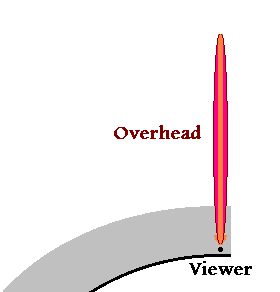
| |
 |
Just as electrons are not a single particle, but composed of some 387 particles, light is likewise not composed of a single particle, as hundreds of particles are
involved in the phenomenon called light. This should be obvious to man, as light spreads into the colors of the rainbow, and as his scientists describe the behavior of
red light as Red Shift, where no such behavior is ascribed to other colors in the light spectrum. How does this affect viewing the inbound Planet X, which emits light
primarily in the red spectrum due to the cloud of red dust around it though which any light escaping from the planet must pass. Red light, and light close in the
spectrum to red light, bends more readily than other particles in the light group. This can quickly be determined by the common man if he compares the rising and
setting sun to other objects he sees in the sky.
 The rising and setting sun are huge, compared to their appearance at mid-day. This is due to the light rays which
have been bent and would otherwise escape to the side, being bent back by the atmosphere so they enter the
viewers eye as though coming from a large orange sun. Do these rays not get bent in this manner at mid-day? They
do, but there are several factors which make the phenomena apparent at dawn and dusk.
The rising and setting sun are huge, compared to their appearance at mid-day. This is due to the light rays which
have been bent and would otherwise escape to the side, being bent back by the atmosphere so they enter the
viewers eye as though coming from a large orange sun. Do these rays not get bent in this manner at mid-day? They
do, but there are several factors which make the phenomena apparent at dawn and dusk.
 Thus, in viewing Planet X,
especially when the inbound planet
is faint and small due to being at a
distance, viewing is best when the
spot in the sky is at either horizon,
not overhead. Like the rising or
setting sun, allowing the red
spectrum light to pass at an angle through the atmosphere, thus passing through more atmosphere, makes Planet X seem larger, too. Light rays in the red spectrum
that are bending to the side as they approach Earth are bent back, thus seeming to come from the side of Planet X, an illusion that makes it seem larger. Viewing
Planet X from a distance is also affected by red light being bent by other factors in the solar system, and thus the RA and Dec given seem to vary in an irrational
manner. We give coordinates that will best allow man to locate this red planet, as depending on:
Thus, in viewing Planet X,
especially when the inbound planet
is faint and small due to being at a
distance, viewing is best when the
spot in the sky is at either horizon,
not overhead. Like the rising or
setting sun, allowing the red
spectrum light to pass at an angle through the atmosphere, thus passing through more atmosphere, makes Planet X seem larger, too. Light rays in the red spectrum
that are bending to the side as they approach Earth are bent back, thus seeming to come from the side of Planet X, an illusion that makes it seem larger. Viewing
Planet X from a distance is also affected by red light being bent by other factors in the solar system, and thus the RA and Dec given seem to vary in an irrational
manner. We give coordinates that will best allow man to locate this red planet, as depending on:
The advise for those seeking a peek are to look around the spot given, filtering only for light in the red spectrum, in particular infrared, and comparing what they see against established and published star charts. The RA and Dec given are close enough that this practice will bring success, and giving specialized coordinates to this and that viewer, for this or that day, will not much improve this effort as so many other factors are at play. Thus, we will cease the practice of giving special coordinates from this date forward, as the viewing public is going to increase in numbers during 2002 and these requests will overwhelm an already exhausted Nancy. Follow the guidelines given, and spend your efforts there, rather than making demands of Nancy.